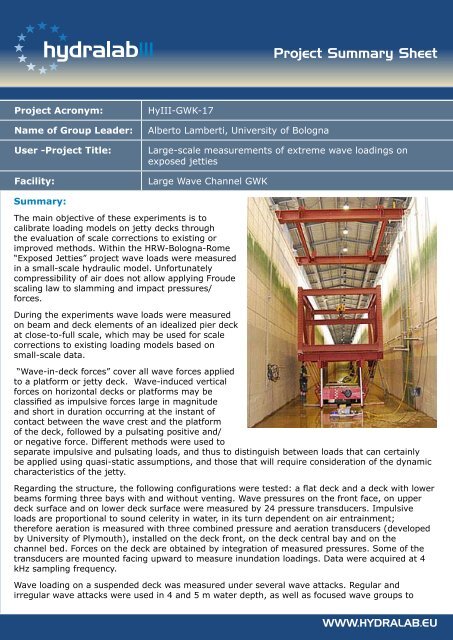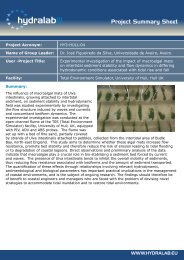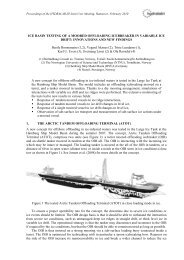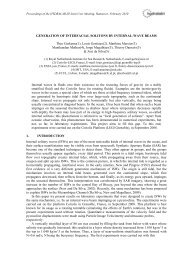Project Summary Sheet
Project Summary Sheet
Project Summary Sheet
Create successful ePaper yourself
Turn your PDF publications into a flip-book with our unique Google optimized e-Paper software.
<strong>Project</strong> <strong>Summary</strong> <strong>Sheet</strong><br />
<strong>Project</strong> Acronym:<br />
Name of Group Leader:<br />
User -<strong>Project</strong> Title:<br />
Facility:<br />
HyIII-GWK-17<br />
Alberto Lamberti, University of Bologna<br />
Large-scale measurements of extreme wave loadings on<br />
exposed jetties<br />
Large Wave Channel GWK<br />
<strong>Summary</strong>:<br />
The main objective of these experiments is to<br />
calibrate loading models on jetty decks through<br />
the evaluation of scale corrections to existing or<br />
improved methods. Within the HRW-Bologna-Rome<br />
“Exposed Jetties” project wave loads were measured<br />
in a small-scale hydraulic model. Unfortunately<br />
compressibility of air does not allow applying Froude<br />
scaling law to slamming and impact pressures/<br />
forces.<br />
During the experiments wave loads were measured<br />
on beam and deck elements of an idealized pier deck<br />
at close-to-full scale, which may be used for scale<br />
corrections to existing loading models based on<br />
small-scale data.<br />
“Wave-in-deck forces” cover all wave forces applied<br />
to a platform or jetty deck. Wave-induced vertical<br />
forces on horizontal decks or platforms may be<br />
classified as impulsive forces large in magnitude<br />
and short in duration occurring at the instant of<br />
contact between the wave crest and the platform<br />
of the deck, followed by a pulsating positive and/<br />
or negative force. Different methods were used to<br />
separate impulsive and pulsating loads, and thus to distinguish between loads that can certainly<br />
be applied using quasi-static assumptions, and those that will require consideration of the dynamic<br />
characteristics of the jetty.<br />
Regarding the structure, the following configurations were tested: a flat deck and a deck with lower<br />
beams forming three bays with and without venting. Wave pressures on the front face, on upper<br />
deck surface and on lower deck surface were measured by 24 pressure transducers. Impulsive<br />
loads are proportional to sound celerity in water, in its turn dependent on air entrainment;<br />
therefore aeration is measured with three combined pressure and aeration transducers (developed<br />
by University of Plymouth), installed on the deck front, on the deck central bay and on the<br />
channel bed. Forces on the deck are obtained by integration of measured pressures. Some of the<br />
transducers are mounted facing upward to measure inundation loadings. Data were acquired at 4<br />
kHz sampling frequency.<br />
Wave loading on a suspended deck was measured under several wave attacks. Regular and<br />
irregular wave attacks were used in 4 and 5 m water depth, as well as focused wave groups to<br />
WWW.HYDRALAB.EU
<strong>Project</strong> <strong>Summary</strong> <strong>Sheet</strong><br />
generate the highest waves in irregular attacks that could not be generated in their entirety.<br />
Measurements included incident, reflected and transmitted waves, and velocity profiles along the<br />
vertical in front of the structure. Videos are available for all tests.<br />
Wave loading was measured under very well documented conditions and with a very high time<br />
resolution. Data are compared with small scale tests results according to Froude scaling law<br />
and differences were identified. A scaling law for loading accounting for scale effects due to air<br />
compressibility and different air content was proposed and verified.<br />
The focused wave group technique, which could allow much shorter tests enabling evaluation of<br />
extreme loads, was verified by comparison with long duration irregular wave tests.<br />
The existing guidelines (K. McConnell et al., 2004) will be updated if necessary accounting for the<br />
new results, providing in any case more reliable estimates of full scale loading.<br />
Publications:<br />
WWW.HYDRALAB.EU












